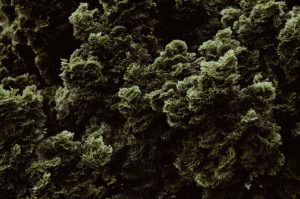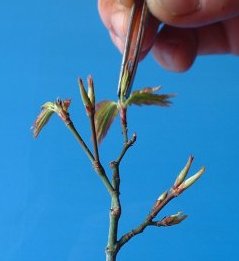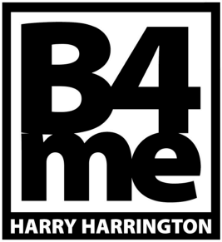/
Note: This article is intended to be read as part of the ‘Repotting and Rootpruning’ series.
After a number of years in a pot, all soils begin to break down and congeal. Soils that have broken down become dense and airless.
The majority of the old soil is removed during the normal course of repotting, however the inner core of old soil around the base of the tree and in the centre still remains and it is important that this is removed and fresh soil introduced on a regular basis.
If poor-quality or old soil is left around the centre of the rootball, it will eventually cause root rot as well as reducing the amount of healthy soil for the bonsai to root into and therefore the uptake of moisture and nutrients by the rootsystem. It would not be unusual for root rot to occur at the very centre of the rootball attacking the nebari/trunkbase whilst the exterior roots remain healthy.
If you suspect that a tree has a weak rootsystem but can see no obvious sign of ill-health around the periphery of the rootsystem; bare-root the tree and check the condition of the inside of the rootball.
It is important that bonsai are completely bare-rooted to remove all old and tired soils at least every 5 years. Unless you are very certain of the soil used throughout the pot, any newly purchased trees should be bare-rooted at their first repotting. Field-grown and most collected trees/yamadori should also be bare-rooted before potting up.
All mallsai are normally grown in very poor soils (particularly those bought in the UK) and should be bare-rooted during their first repotting.
One major advantage of bare-rooting a bonsai is that it is easier to study the rootball and remove unsuitably placed roots around the nebari and inspect for any damaged roots.
Deciduous and broadleaf trees can be bare-rooted without any detriment to their health; more care must be taken with coniferous species such as Junipers and Pines. I would recommend removing all old soil by hand but not washing the roots.
After bare-rooting, extra care must be taken that soil is introduced all the way around the bare rootball. Use a soil that is dry as it is easier to introduce and gently work it in and around the rootball with your fingers and a chopstick. After repotting, water the soil very thoroughly so that no air pockets remain.
Bare-rooting an Elm bonsai
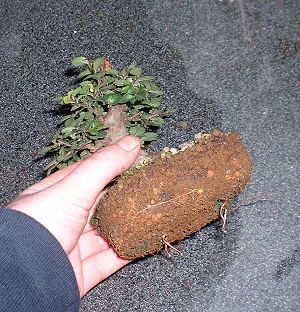
This mame Chinese Elm was last repotted a year ago but has quickly become rootbound.

The excess soil around the edge of the rootball is teased away by hand or with a chopstick.
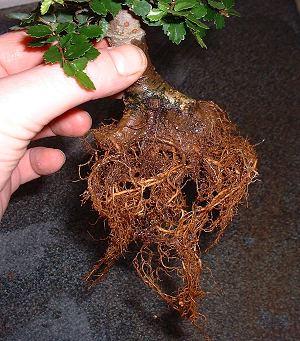
The rootball is then gently rinsed using a weak jet of water; any hard pockets of soil are carefully removed with the chopstick.
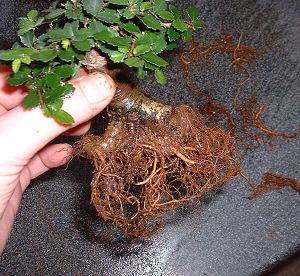
The roots are then trimmed; this tree is being planted into a slightly larger mame pot and so the roots need less trimming than normal. Attention is given to removing or trimming back thicker roots and leaving the finer roots if possible. Although not obvious in this picture, the roots underneath the rootball are also trimmed hard to encourage a shallower rootball and to encourage more lateral rooting from the nebari.
Bare-rooting a second Elm
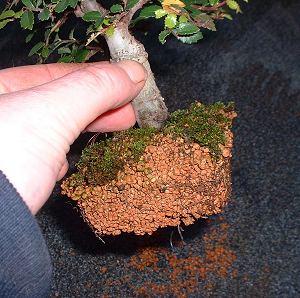
This second Elm was last repotted a year ago into a tiny mame pot. During midsummer it was potted up into a larger mame pot (without disturbing the rootball).

After first removing the soil by hand; this tree had been planted in Akadama soil which has broken down quickly and needs to be thoroughly cleaned.
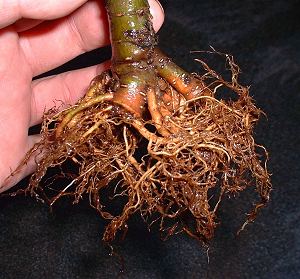
After washing the roots.
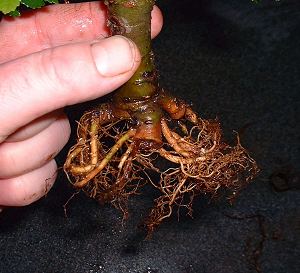
Again the roots are trimmed, this tree is to be repotted into a very shallow pot and the roots below the root pad are pruned particularly hard to produce a shallow rootball.
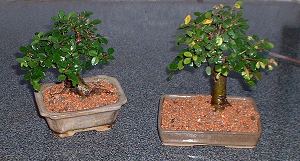
The two Elms repotted.


